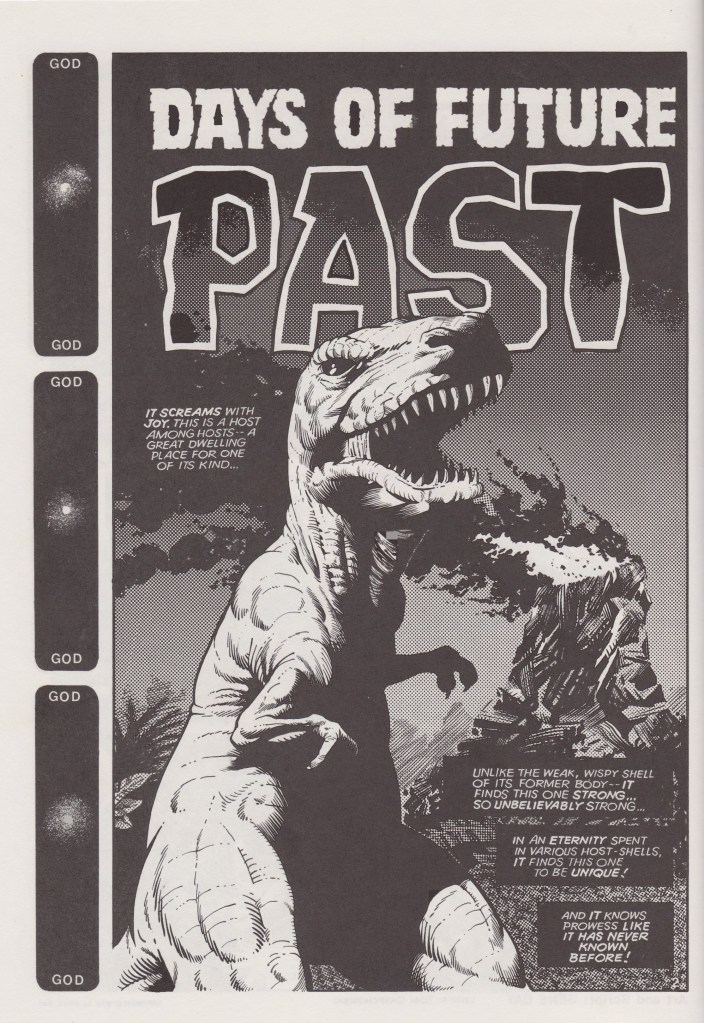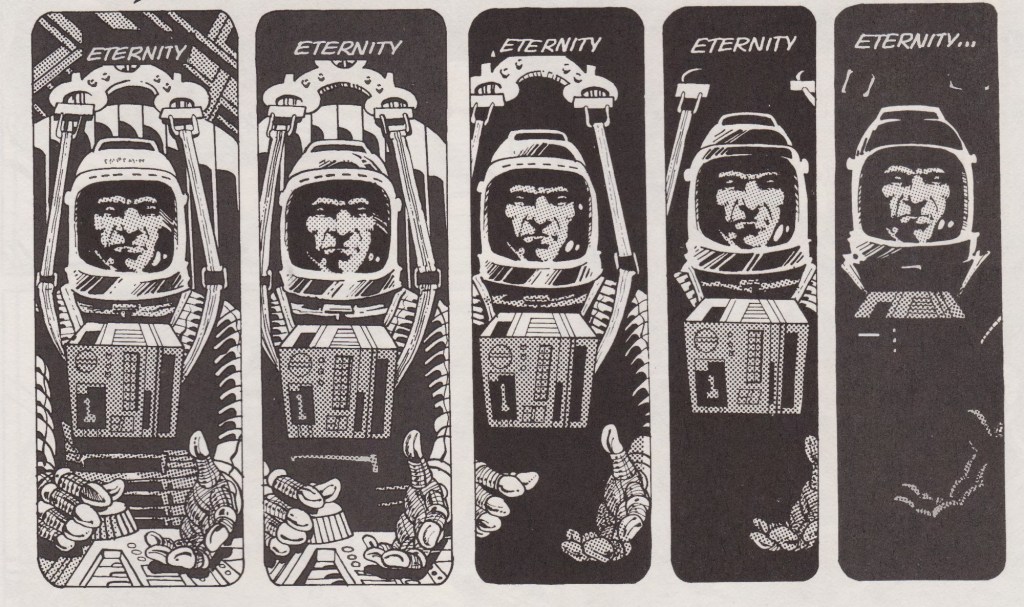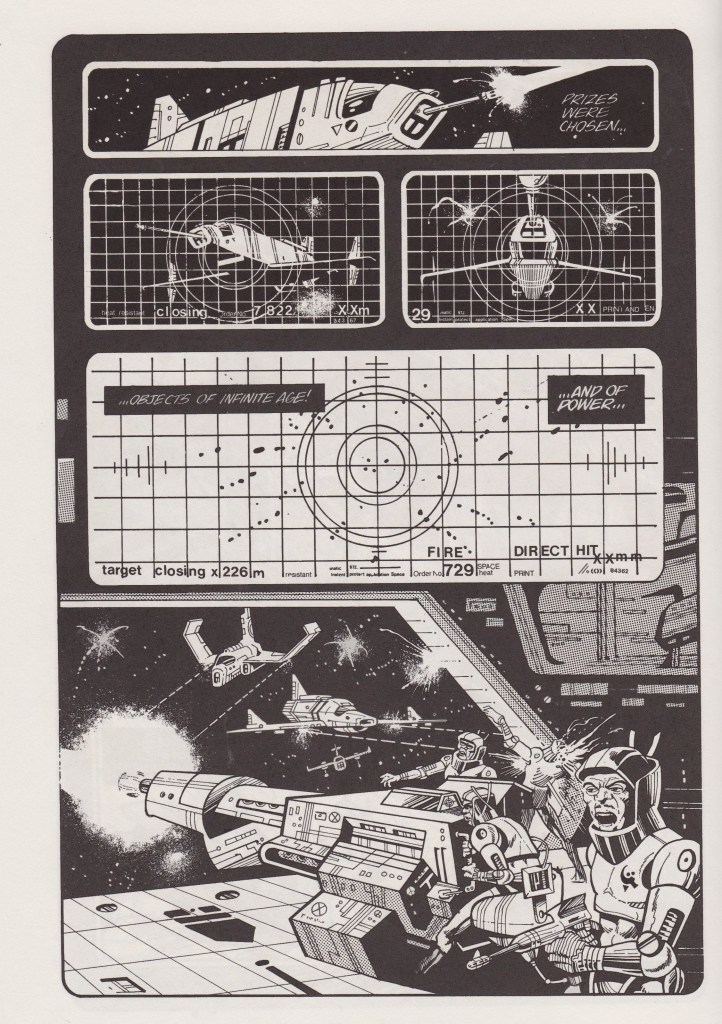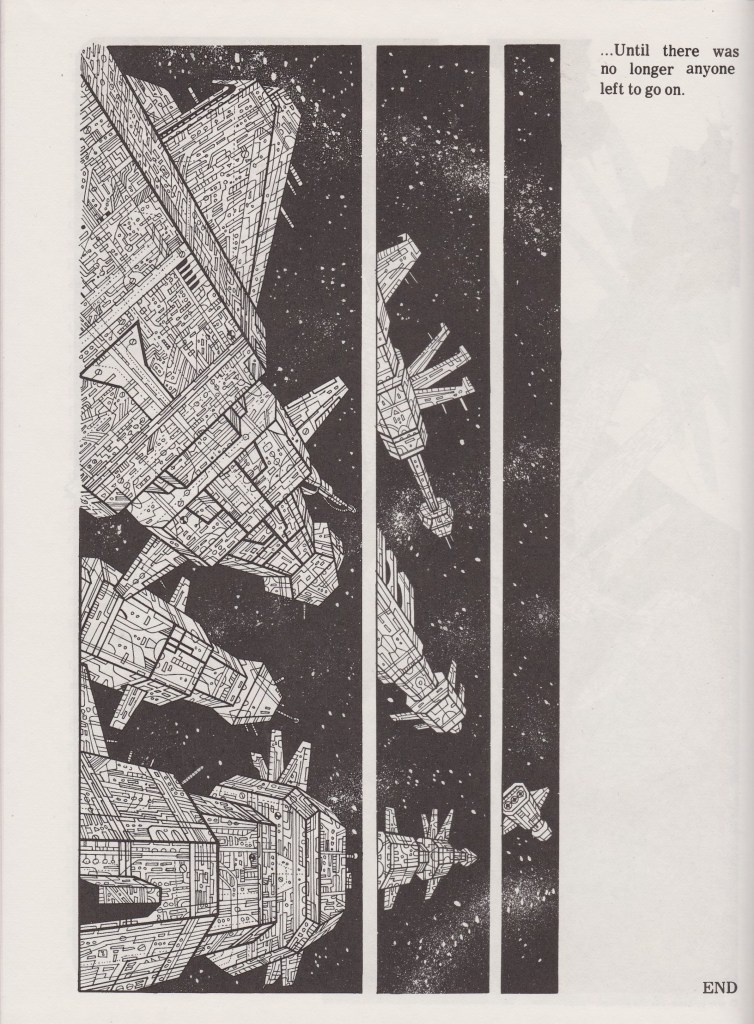
Gene Day’s cover for Future Day (1979)
Comic book author and artist Gene Day (1951-1982) is best known for his SF work on Marvel Comics’ Star Wars series and as an editor and artist for Dark Fantasy (1973-1980). He also created art for Chaosium games including Nomad Gods (1977). My brief bibliographic blurb is based on Wikipedia. Here is a wonderful gallery of his work including images from his various Star Wars publications.
Future Day (1979), a “graphic album,” contains seven “graphic stories” on themes of galactic conflict. It might be worth comparing Day’s rather nihilistic formulations of war and galactic expansion/conquest with the positivist depiction of heroic liberation in Star Wars. I would suggest that Day is deliberately responding to the phenomenon of Star Wars: Episode IV – A New Hope (1977). The art and storylines are filled with indirect correlates to the Star Wars universe (“cute” R2D2-esque robots, hulking spaceships with similar details to imperial cruisers and X-wings, etc.)
I’ve not been that impressed with the three SF comic books I’ve tackled so far on my site — Paul Gillon’s The Survivor, 1 (1985), Samuel R. Delany and Howard V. Chaykin’s Empire (1978), or Gene Day’s Future Day (1979). While I enjoy the art and individual panels of text/image, I struggle with the bland/simplistic stories. I’m going to refrain from rating this one as I don’t think I’m the best judge of their merits. That said, I am always interested in exploring the genre in all its formulations from my decades of interest!
A note about dates and publication: None of the stories were previously published elsewhere. I’ve included the date (when present) as signed by Day. I defaulted to 1979 if no date exists. I own a limited Collector’s Edition (volume 308 of 500) signed by the author.
“Gifts of Silver Splendor” (1979): The last Acton, Nevorhien-B, wages a lost crusade against the Lizard-Men of Senti. Day presents a punchy progenitor narrative common in so much SF–homo sapiens aren’t responsible for their achievements but rather are uplifted by ancient alien knowledge. War as an act of cosmic fertilization… Other than the striking first panel of Nevorhien-B linked into his “thought-ship,” “Gifts” lacks the imaginative power of some of the other shorts in the collection.
“Hive” (1978): Another final conflicts wraps up the final threads…. a “Queen” and her last drone attempt to fight off the last wave of invaders. The fighting moves inward, from outside a vast spaceship to the final room. There’s a nihilistic twist. This is humanity’s final final stand. Day’s brutal conflicts engage with final moments. Last gasps and blows. Warfare cannot be avoided. Battle lines are draw for perpetuity.

“Days of Future Past” (1978)
“Days of Future Past” (1978): A silly homage to Bradbury’s “A Sound of Thunder” (1952), “Days of Future Past” places an alien entity that threatens to change the course of history into the body of a ferocious dinosaur. Time-travels end up changing the narrative but in different ways than they imagined.
“Gauntlet” (1978): As with others in the collection, Day’s formulation of war treads into more disturbing territory. In this instance, a galactic conflict with spaceships that look like airplanes against massive alien ships is but a hellish testing apparatus (that inflicts real injuries?) for modern-day (?) pilots.

“Paper Dragon” (1977)
“Paper Dragon” (1977) contains the most powerful and inventive use of image and text in the collection. The story itself is completely forgettable. Day attempts to present a dystopic future where mass warfare creates unintended consequences that threaten to end the human race. A new scientific discovery creates a new more existential nightmare… a hodge-podge of ideas that don’t mesh.

“War Games” (1977)
“War Games” (1977) is the best realized vision in the collection. War, cue Day’s relentless themes on conflict discussed above, drags on and on. The original causes cannot be extricated from the morass of the past. Instead, a new logic defines conflict–possession of the physical tokens of representing humanity dictates the moves and countermoves of galactic conquerors. “War Games” contains striking images and effective use of text. The only story I recommend from the collection!
“Black Legion” (1977): More of an illustrated short story than the others in the volume, “Black Legion” lays out the final movement in another galactic conflict. Here a galactic horde relentlessly searches for food to maintain its ability to push onward. But this path is but entropic fizzle… the empty hulks remain littering the stars.

“Black Legion” (1977)
For book reviews consult the INDEX
For cover art posts consult the INDEX
For TV and film reviews consult the INDEX
Can’t abide comic books. Sorry for your agonies.
Not willing to give up hope yet! There are some stunning modern graphic novels (this “collection” feels a bit more like an episodic graphic novel rather than comic but I’m no expert on these distinctions) — My Favorite Thing Is Monsters (2017) comes to mind: https://www.amazon.com/Favorite-Thing-Monsters-Emil-Ferris/dp/1606999591
And the Delany and Chaykin collaboration I reviewed a while back was almost good….
“Almost good” isn’t quite the ringing endorsement I’ll need to overcome my distaste.
So there isn’t a single modern or old graphic novel you’ve enjoyed?
Oh no, not at all the case. I force myself to read graphic novels regularly so I won’t succumb to unexamined prejudice downer syndrome.
NATIONALIST LOVE was the latest five-starrer. https://expendablemudge.blogspot.com/2021/06/nationalist-love-polish-graphic-novel.html
Ah, well with that in mind check out the 2017 volume I linked. Might be worth the read!
Ah, well with that in mind check out the 2017 volume I linked. Might be worth the read!
NONONONONONONONONONONONO
you’re not supposed to fatten my TBR here!! you’re SUPPOSED to steer me away from re-reading stuff I’ve already read, or warn me off things I shouldn’t seek out! You had ONE JOB!!
Science fiction comics were/are the entry drug for boys (mostly) who’ll later become written SF readers and so tend almost without exception to be puerile. Certainly, I struggle to think of any American SF comics that are worth anything. Maybe Howard Chaykin’s AMERICAN FLAGG (1983-89) —
https://en.wikipedia.org/wiki/American_Flagg!
— though I only glanced at some of its issues, being somewhat beyond the comic-buying age at that point.
You’d be better off looking at the Europeans, meaning principally the French and the British. Among the French, you might try Enki Bilal —
https://en.wikipedia.org/wiki/Enki_Bilal
…and in particular his NIKOPOL trilogy (all translated and published in the US, though how easy they are to get these days I can’t say–
https://en.wikipedia.org/wiki/La_Foire_aux_immortels
https://en.wikipedia.org/wiki/La_Femme_Pi%C3%A8ge
https://en.wikipedia.org/wiki/Froid_%C3%89quateur
That said, the French tend to the mythopoeic science-fantasy side of things and the arguably not-real-SF (I’ve no arguments with that, when the French do it as well as they often do). You’ll find a fusion of the Anglo and the French styles in THE LONG TOMORROW (1975) with art by the great Moebius and script by Dan O’Bannon, who wrote the Ridley Scott movie ALIEN and others) —
https://en.wikipedia.org/wiki/The_Long_Tomorrow_(comics)
As William Gibson noted, with particular reference to THE LONG TOMORROW: “It’s entirely fair to say, and I’ve said it before, that the way Neuromancer-the-novel ‘looks’ was influenced in large part by some of the artwork I saw in ‘Heavy Metal’. I assume that this must also be true of John Carpenter’s Escape from New York, Ridley Scott’s Blade Runner, and all other artifacts of the style sometimes dubbed ‘cyberpunk’. Those French guys, they got their end in early.”
Thanks for the list!
The premise of Howard Chaykin’s AMERICAN FLAGG (1983-89) seems like a satire I might enjoy… And I loved his art in the Delany collab Empire (1978) I reviewed on the site. I’ll also look around for The Long Tomorrow (1975). Can’t promise I’ll get to them any time soon. As you know…
As for the Brits, you might try Warren Ellis’s THE MINISTRY OF SPACE —
https://en.wikipedia.org/wiki/Ministry_of_Space
Although, essentially, the likes of Ellis, Alan Moore, Neil Gaiman, and many more didn’t come out of nowhere. Rather, there’s a long tradition of British comics, with a SF strip called DAN DARE in the 1950s probably the foundation stone. Comics stand or fall on their art and the Brits had some of the best SF illustrators — unfortunately, working mostly for boys’ comics. The art is what DAN DARE is chiefly significant for (and its Brit-centric retro-futurism influenced Ellis’s MINISTRY OF SPACE). As the COMICS JOURNAL notes: —
“The original Dan Dare is notable for a lot of things, but to me the most interesting thing is the counterintuitive method of its creation: a lavish budget, a full studio, a team of four assistants, photo references galore, and the scientific advisory of famed science fiction writer Arthur C. Clark. All of this? To draw two pages per week. This seems so out of bounds with the realities of commercial comics …. one wonders how it could have lasted. The answer is, of course, financial success. The first issue sold 900,000 copies, and by the time the title died in 1969, sales fell to a dismal 150,000 copies in Britain alone – enough to make it a number one title in the American market today ….
“…Hampson, and his colleagues, attempted … a lot of technical stuff that is sure to excite any gearhead. Whereas many science fiction strips … treat the science as an afterthought, it is satisfying to see the art respect the improbable nature of these rockets and ships …Early Dan Dare stories did respect their craft, and thus, their readers as well. There’s a real ‘spared no expense’ sense to these tales with their neverending parade of background, complex machines, large scale battles and ever growing cast – all while trying to adhere to a degree of realism….”
http://www.tcj.com/man-out-of-time/
Me again: This meant in practice 16-20 panels weekly rendered to a level pretty much unseen elsewhere and resembling nothing in American comics —
http://www.dan-dare.org/DareShow3.htm
In context….

https://johnknifton.files.wordpress.com/2018/05/dan-dare.jpg?w=650&h=864
Hello Mark,
Thanks for all the fascinating images/authors you’ve listed.
I know of Don Dare although I haven’t read any of them. I’ll investigate. As for Warren Ellis’ Ministry of Space (2001-2004), I’m really only interested in SF comics from my area of interest (50s-80s). My toleration of a genre I do not enjoy is more due to my historical fascination with the period. haha.
That said, some of the earlier ones you mentioned intrigue a bit more — mostly Enki Bilal. Although the price tag (around $35 with shipping) of the translated three volumes of the Nikopol trilogy is too prohibitive for someone with but a passing interest in the genre… I’ll put it on my “to acquire” list and wait for a cheaper copy to pop up.
Yeah, I’ve thought about buying the Bilal books over the years and been put off by the prices.
Sorry about posting one of the Dan Dare images twice.
JB: I know of Don Dare although I haven’t read any of them. I’ll investigate.
You probably shouldn’t.
The art is often glorious, as you see. But the scripts are for boys, and for British boys at a time when the empire was still around (though ending) at that.
Though there’s a certain steampunk-adjacent pleasure to be had from the fact that Dan Dare is basically an RAF pilot, Space Fleet scrambles spaceships against a threat just like RAF fighter squadrons did during the Battle of Britain, and in the early strips the rocket spaceships have transparent fronts for the pilots just like B-29s.
I understand. As I mentioned above, part of the fun exploring SF comics and texts is a purely historical enterprise — which is enjoyable regardless of my personal like or dislike. I’ve contemplated completely ditching ratings as a result. But… that’s not how a lot of people read.
I enjoyed Gene Day’s work on the 1970s Master of Kung Fu comic from Marvel. The “real” Shang Chi who was pretty much Bruce Lee with longer hair. 😂 So sad that Gene Day passed away so young; only 31 years old. Aside from his work on Star Wars, I wasn’t aware of his other SF work, so I appreciate your post. Also, great comments here.
Thanks for stopping by — and apologize for the delayed response (August is always my most intense month as I return after summer break).
Glad you enjoyed the post. If shipping was cheaper to Japan, I’d send this your way.
Hey, don’t worry about it. Yeah, great post and comments, thanks Joachim.
Hi again!
Well, comics are not really my cup of tea; but there some french masters and of course Windsor Mccay.
We have in Sweden a very interesting artist in this field: John Andersson. I know he has hallucinations, but he denies any kind of illness.
Addenda: The World of John Andersson; a film to be seen om YouTube.
I don’t know Windsor Mccay. What are his highlights?
I think I have some SF comic books jammed (and hidden) in my three overloaded SFFH bookshelves. Something tells me (I don’t know because it’s buried two rows back probably) I have a book called “I-Caliban,” though maybe it’s more of an SF book with illustrations? No panels & gutters per se. Very similar art work, however.
But is it any good? At this point in my failed attempt to enjoy comics, it better be extraordinary! hahaha. alas.
Haven’t read it – but probably skimmed a bit after first purchasing it; I don’t remember anything grabbing me…
This looks really interesting. The art is absolutely stunning too. I like the idea of responding to the Star Wars optimism.
I’m a comic reader from way back. I still enjoy them. But recently I got the EV comics Bradbury adaptations which has been very well reviewed. They leave me somewhat cold though. Maybe because you just can’t match Bradbury’s imagery, or possibly because they are so condensed — I like a story to really unfold over many pages. Much of the art is wonderful though.
I bounce off most comics. But in attempt to better know SF from the decades that interest me (1945-1985) I sometimes give them a chance….